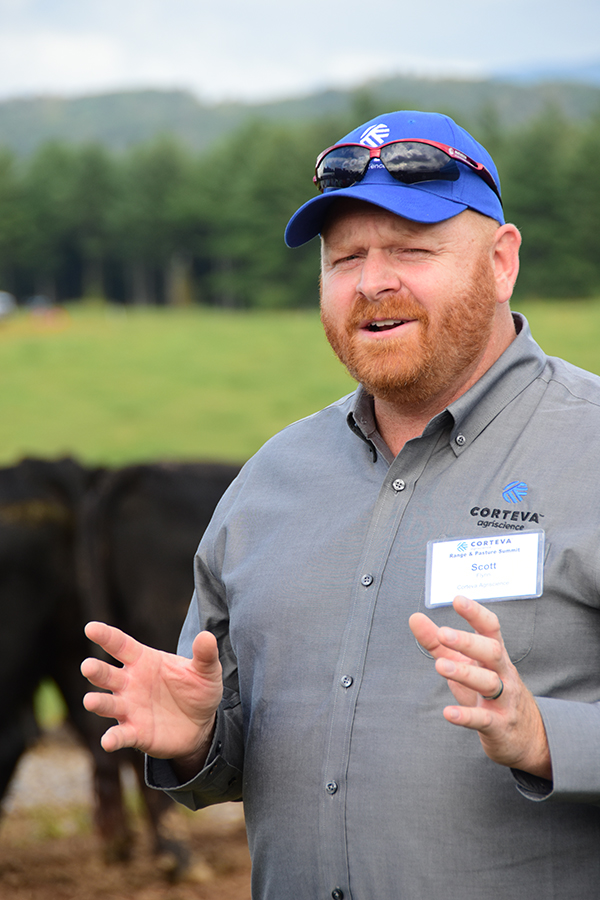Weeds cost you more than you might think

You know generally that weeds in a pasture compete with forage grasses for space, sunlight, soil nutrients and moisture. But the exact numbers are interesting.
You know generally that weeds in a pasture compete with forage grasses for space, sunlight, soil nutrients and moisture. But the exact numbers are interesting.
Consider just nitrogen.
Nitrogen (N) is one of the major soil nutrients that forage grasses need for growth. And nitrogen usually is one of the two most limiting factors in grass production. (Moisture usually is the top limiting factor.)
Many common broadleaf weeds have higher nitrogen contents — and requirements — than forage grasses. Note the table here compiled by Corteva Agriscience field scientist Scott Flynn, Ph.D.
NITROGEN CONTENT OF COMMON BROADLEAF WEEDS |
|||
| Weed species | Nitrogen (N) content at midbloom | N removal/A/500 lb. of weed pressure | Forage yield loss (dry matter)* |
| Canada thistle | 2.7% | 14 | 560 lb. DM |
| Common lambsquarters | 2.9% | 14 | 560 lb. DM |
| Common ragweed | 3.4% | 17 | 680 lb. DM |
| Curly dock | 3.0% | 15 | 600 lb. DM |
| Henbit | 3.2% | 16 | 640 lb. DM |
| Redroot pigweed | 2.7% | 14 | 560 lb. DM |
| Virginia pepperweed | 4.2% | 21 | 840 lb. DM |
| Grass species | |||
| Smooth bromegrass | 2.6% | 13 | |
| Tall fescue | 2.2% | 11 | |
| Bermudagrass | 2.2% | 9 | |
| Compiled by Scott Flynn, Ph.D. | *at 40 lb. DM/lb. N | ||
In 1 acre, 500 pounds of Canada thistle or redroot pigweed at midbloom remove 14 pounds of nitrogen. And those two are relatively low users among weeds. Common ragweed takes 17 pounds; Virginia pepperweed, 21.
 Scott Flynn, Ph.D.
Scott Flynn, Ph.D.In contrast, common forage grasses take less nitrogen. In that 1 acre, 500 pounds of bermudagrass removes just 9 pounds of nitrogen and tall fescue, 11.
In a pasture acre that produces 3,000 pounds of dry matter, that 500 pounds of weeds would be less than 17% of the total biomass. If the pasture produces 6,000 pounds of dry matter, it’s about 8%. “Many producers would consider that a fairly small problem, but those weeds still cost you forage dry matter,” Flynn says.
The loss of 14 pounds of nitrogen costs you more than 500 pounds of forage dry matter per acre. That’s forage you could bale or your cows could graze.
Just 500 pounds of ragweed per acre takes away 680 pounds of forage dry matter. What’s that worth? If hay is priced at $70 per ton, that’s 3.5 cents per pound as fed. Hay is typically 85% dry matter, so on a dry matter basis, it’s 4.1 cents per pound (3.5/0.85). So 680 pounds of forage dry matter is worth $27.88 (680 x 0.041). If hay is worth $100 per ton as fed, the 680-pound dry matter loss costs you $39.44 per acre.
Note, too, that 500 pounds of the example weeds reduce forage yield by more than 500 pounds. That’s more than 1 pound of grass lost for every pound of weeds grown, just from the loss of nitrogen. But the equation works both ways: You can reclaim that lost production via weed control.
“Weed control reallocates resources from something that costs you to something that makes you money,” Flynn says. “And remember: These numbers show only the effect of N consumed by weeds. They don’t account for shading, space taken or moisture removed. So here we’re just looking at a portion of the story. It doesn’t take too many weeds in a pasture to be expensive.”
Learn about seasonal opportunities, rancher success stories, and management strategies for pastures and rangeland.